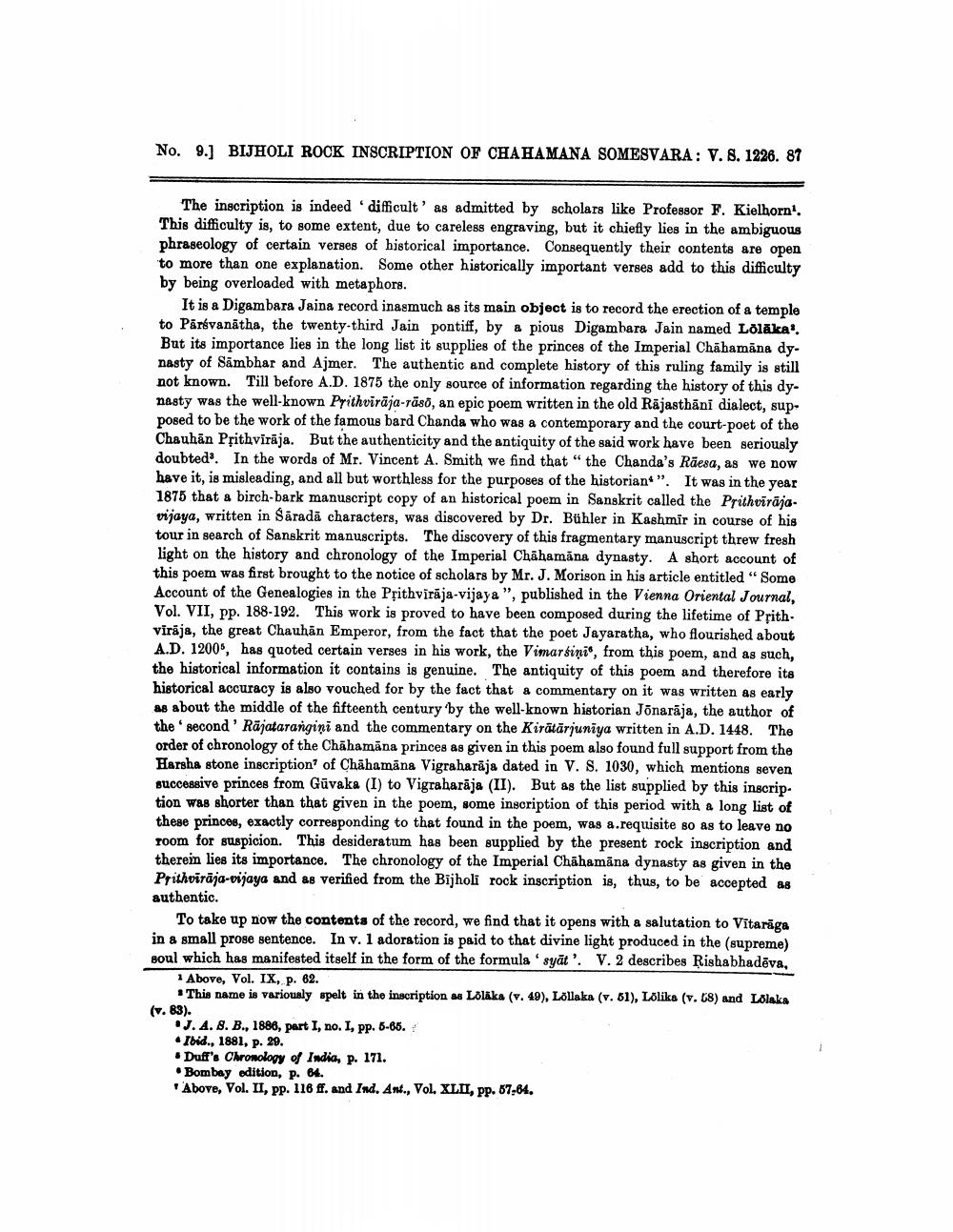________________
No. 9.] BIJHOLI ROCK INSCRIPTION OF CHAHAMANA SOMESVARA: V. S. 1226. 87
The inscription is indeed difficult' as admitted by scholars like Professor F. Kielhorn! This difficulty is, to some extent, due to careless engraving, but it chiefly lies in the ambiguous phraseology of certain verses of historical importance. Consequently their contents are open to more than one explanation. Some other historically important verses add to this difficulty by being overloaded with metaphors.
It is a Digambara Jaina record inasmuch as its main object is to record the erection of a temple to Pārsvanātha, the twenty-third Jain pontiff, by a pious Digambara Jain named Lolāka! But its importance lies in the long list it supplies of the princes of the Imperial Chāhamāna dynasty of Sambhar and Ajmer. The authentic and complete history of this ruling family is still not known. Till before A.D. 1875 the only source of information regarding the history of this dynasty was the well-known Prithviraja-rāso, an epic poem written in the old Rajasthani dialect, supposed to be the work of the famous bard Chanda who was a contemporary and the court-poet of the Chauhan Prithviraja. But the authenticity and the antiquity of the said work have been seriously doubted. In the words of Mr. Vincent A. Smith we find that “the Chanda's Räesa, as we now have it, is misleading, and all but worthless for the purposes of the historiant". It was in the year 1875 that a birch-bark manuscript copy of an historical poem in Sanskrit called the Prithviraja. vijaya, written in Săradă characters, was discovered by Dr. Bühler in Kashmir in course of his tour in search of Sanskrit manuscripts. The discovery of this fragmentary manuscript threw fresh light on the history and chronology of the Imperial Chāhamăna dynasty. A short account of this poem was first brought to the notice of scholars by Mr. J. Morison in his article entitled " Some Account of the Genealogies in the Prithvirāja-vijaya", published in the Vienna Oriental Journal, Vol. VII, pp. 188-192. This work is proved to have been composed during the lifetime of Prith. virāja, the great Chauhan Emperor, from the fact that the poet Jayaratha, who flourished about A.D. 1200$, has quoted certain verses in his work, the Vimarsinis, from this poem, and as such, the historical information it contains is genuine. The antiquity of this poem and therefore its historical accuracy is also vouched for by the fact that a commentary on it was written as early as about the middle of the fifteenth century 'by the well-known historian Jõnarāja, the author of the second 'Rājatarangini and the commentary on the Kirātārjuniya written in A.D. 1448. The order of chronology of the Chāhamāna princes as given in this poem also found full support from the Harsha stone inscription of Chāhamāna Vigraharāja dated in V. S. 1030, which mentions seven successive princes from Güvaka (I) to Vigraharāja (II). But as the list supplied by this inscrip. tion was shorter than that given in the poem, some inscription of this period with a long list of these princes, exactly corresponding to that found in the poem, was a.requisite so as to leave no room for suspicion. This desideratum has been supplied by the present rock inscription and therein lies its importance. The chronology of the Imperial Chahamāna dynasty as given in the Prithvīrāja-vijaya and as verified from the Bījholi rock inscription is, thus, to be accepted as authentic.
To take up now the contents of the record, we find that it opens with a salutation to Vītaraga in a small prose sentence. In v. 1 adoration is paid to that divine light produced in the (supreme) soul which has manifested itself in the form of the formula' syāt'. V. 2 describes Rishabhadēva.
1 Above, Vol. IX, p. 82.
* This name is variously spelt in the inscription as Loläka (v. 49), Lollaka (v. 61), Lolika (v. 18) and Lolaka (v. B3).
J. A. 8. B., 1888, part I, no. I, pp. 5-86. • Ibid., 1881, p. 29.
Duff's Chronology of India, p. 171. • Bombay edition, p. 84. Above, Vol. II, pp. 116 ff. and Ind. Ant., Vol. XLII, pp. 67.64.




